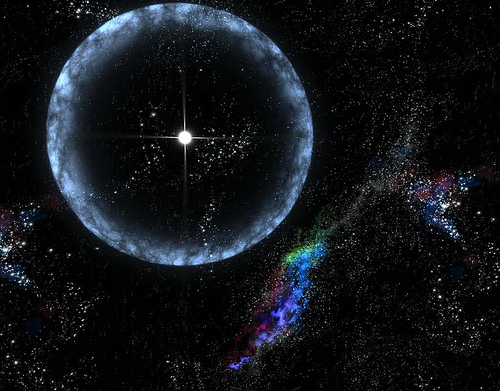Something may be out there. Way out there. On the outskirts of creation, unknown, unseen "structures" are tugging on our universe like cosmic magnets, a controversial new study says.
Everything in the known universe is said to be racing toward the massive clumps of matter at more than 2 million miles (3.2 million kilometers) an hour—a movement the researchers have dubbed dark flow.
The presence of the extra-universal matter suggests that our universe is part of something bigger—a multiverse—and that whatever is out there is very different from the universe we know, according to study leader Alexander Kashlinsky, an astrophysicist at NASA's Goddard Space Flight Center in Maryland.
The theory could rewrite the laws of physics. Current models say the known, or visible, universe—which extends as far as light could have traveled since the big bang—is essentially the same as the rest of space-time (the three dimensions of space plus time).
Dark flow was named in a nod to dark energy and dark matter—two other unexplained astrophysical phenomena. The newfound flow cannot be explained by, and is not directly related to, the expansion of the universe, though the researchers believe the two types of movement are happening at the same time.
In an attempt to simplify the mind-bending concept, Kashlinsky says to picture yourself floating in the middle of a vast ocean. As far as the eye can see, the ocean is smooth and the same in every direction, just as most astronomers believe the universe is. You would think that beyond the horizon, therefore, nothing is different.
"But then you discover a faint but coherent flow in your ocean," Kashlinsky said. "You would deduce that the entire cosmos is not exactly like what you can see within your own horizon."
There must be an out-of-sight mountain river or ravine pushing or pulling the water. Or in the cosmological case, Kashlinsky speculates that "this motion is caused by structures well beyond the current cosmological horizon, which is more than 14 billion light-years away."
The study team didn't set out to explode physics as we know it. They simply wanted to confirm the longstanding notion that the farther away galaxies are, the slower their motion should appear. ...
Hot gas in galaxy clusters warms the microwave background radiation, and "a very tiny component of this temperature fluctuation also contains in itself information about cluster velocity," Kashlinsky said.
If a cluster were moving faster or slower than the universe's background radiation, you'd expect to see the background heated slightly in that region of the universe—the result of a sort of electron-scattering "friction" between the cluster's hot gas and particles in the background radiation.
Because these fluctuations are so faint, the team studied more than 700 galaxy clusters. The researchers had expected to find that, the farther away clusters are, the slower they appear to be moving. Instead, Kashlinsky said, "We found a great surprise."
The clusters were all moving at the same speed—nearly 2 million miles (3.2 million kilometers) an hour —and in a single direction... - natgeo
The back up Blog of the real Xenophilius Lovegood, a slightly mad scientist.
Saturday, November 8, 2008
Unknown "Structures" Tugging at Universe, Study Says
Subscribe to:
Post Comments (Atom)

No comments:
Post a Comment